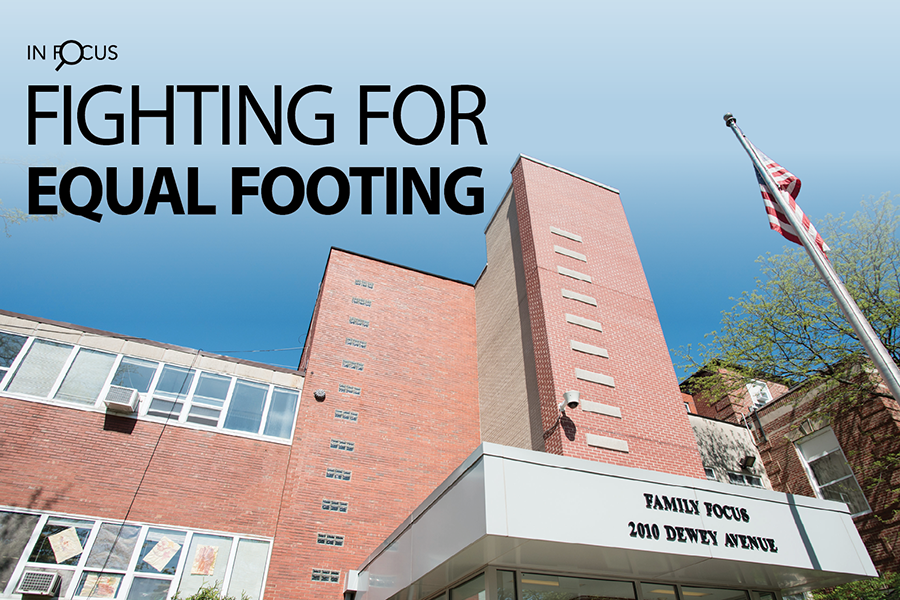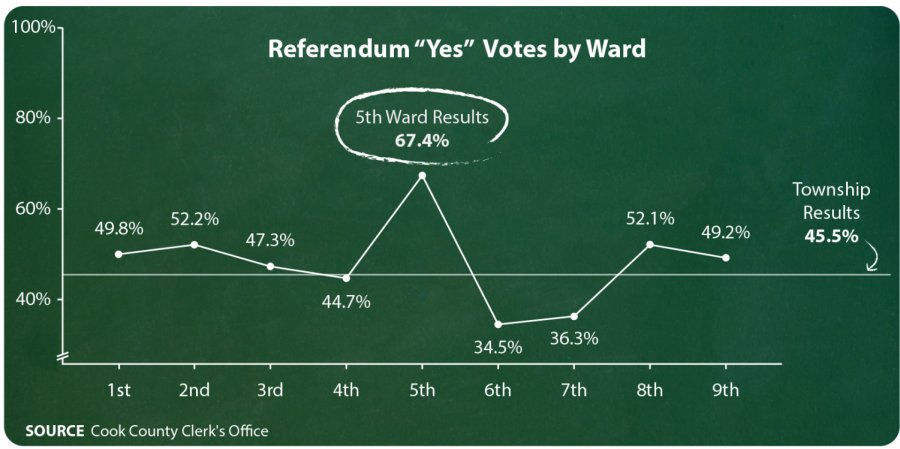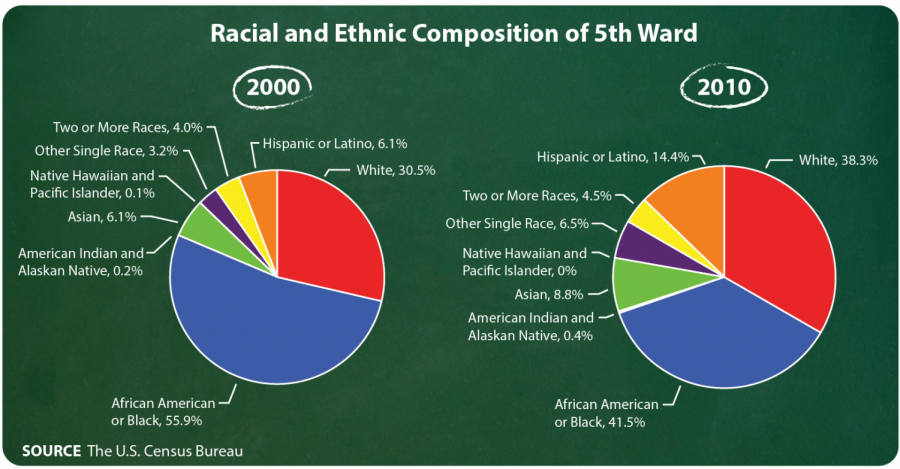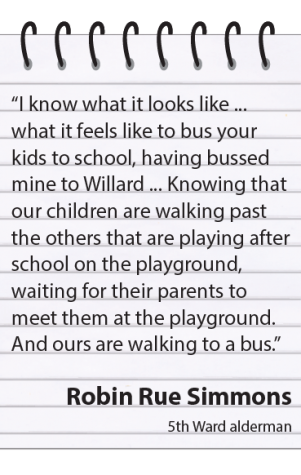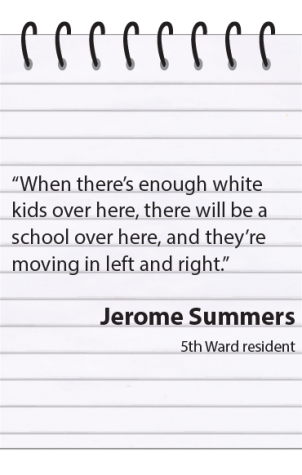In Focus: Fifth Ward residents advocate for neighborhood school in historical building
June 1, 2018
In the 1960s, Jerome Summers was among the first group of students bussed from the only neighborhood school in the historically black 5th Ward to a majority-white school outside of the ward — an effort to further the school district’s goal of eliminating de facto segregation.
As part of that goal, Foster School, the ward’s neighborhood school, began transitioning to a laboratory model in 1967. But just 12 years later, the building closed and its educational programming was moved to a different ward.
The area hasn’t had an Evanston/Skokie School District 65 school since. Decades later, children in the neighborhood are still being bussed to different locations throughout the city.
Summers, a longtime 5th Ward resident, said the ward’s children are feeling the ramifications: The lack of a neighborhood school wasn’t fair or equitable then, and it isn’t now.
“Our children are being harmed,” he said. “When I went to Foster School, every child knew what it was to be the brightness and the hope for the future for everybody they ever saw. Just like all the other kids that go to school in their own neighborhoods.”
Now, Summers said, when classes end, many black and Latinx children board buses to go back to their neighborhood, unable to stay back in their schools’ playgrounds like the children who call those wards home.
“These are not just black and Latino kids; they’re Evanston kids,” he said. “They should have the same advantages that all the other Evanston children have, simple as that.”
The 5th Ward has the highest percentage of black residents in the city at 41.5 percent, based on the most recent census demographic breakdown. Additionally, it is one of the only wards in which no racial group forms a majority and the white population is less than 60 percent.
It is also the only primarily residential ward in Evanston without a neighborhood school. This has drawn ire from those who not only feel their children disproportionately bear the burden of the district’s bussing method, but who also see an absent school as a missed opportunity for increased community cohesion.
Family Focus — an organization that provides community services and now owns the former Foster School building at 2010 Dewey Ave. — recently put the property up for sale, amplifying ongoing concerns over future educational opportunities in the ward and introducing new worries over the potential loss of a historically significant location.
In response, community members have organized two groups in a fight for equal opportunities: one focused on bringing a STEM-focused school into the ward and another on purchasing the Family Focus building.
A ‘historical wrong’
Fifth Ward residents have pushed for a neighborhood school in the past, especially over the last 15 years.
In 2002, the District 65 board raised the possibility of housing a school in the Family Focus building. The negotiations to do so were halted a year later when the board cited financial constraints due to a projected multi-million dollar deficit.
In 2012, the option of building a new school in the ward was put to a city-wide referendum. Even though 5th Ward residents voted overwhelmingly in favor of the proposal, it was shot down 54.7 percent to 45.3 percent due to various concerns, including financial limitations. The referendum would have issued $20.6 million in bonds to fund the new location and bundled an additional cost of over $25 million to fund capital improvements to existing district schools.
Summers, who was a District 65 school board member for eight years, spearheaded that push to bring a school back into the area. He said the effort was catalyzed by his mother, Edna Summers — who served as a 5th Ward alderman for roughly a decade.
“In the end, she was kind of losing it mentally, but one day in a perfect moment of clarity, she said, ‘Son, I apologize for taking you out of the bosom of Foster School and sending you to school with those white folks,’” Summers said. “‘Not because they were white … and not only because they didn’t treat you well, but also because they did not expect much of you.’”
Summers said his mother told him losing Foster School was the “worst mistake” the city ever made. Closing the school, she told him, “pulled the thread that unraveled our community.”
“She just starts sobbing, man, I mean sobbing in my arms,” Summers said. “It just etched into my heart.”
Currently, children in the 5th Ward are bussed to four District 65 elementary schools: Willard, Lincolnwood, Kingsley and Orrington. Parents have the option of requesting to send their kids to K-8 magnet schools King Arts, in Evanston, or Bessie Rhodes, in Skokie.
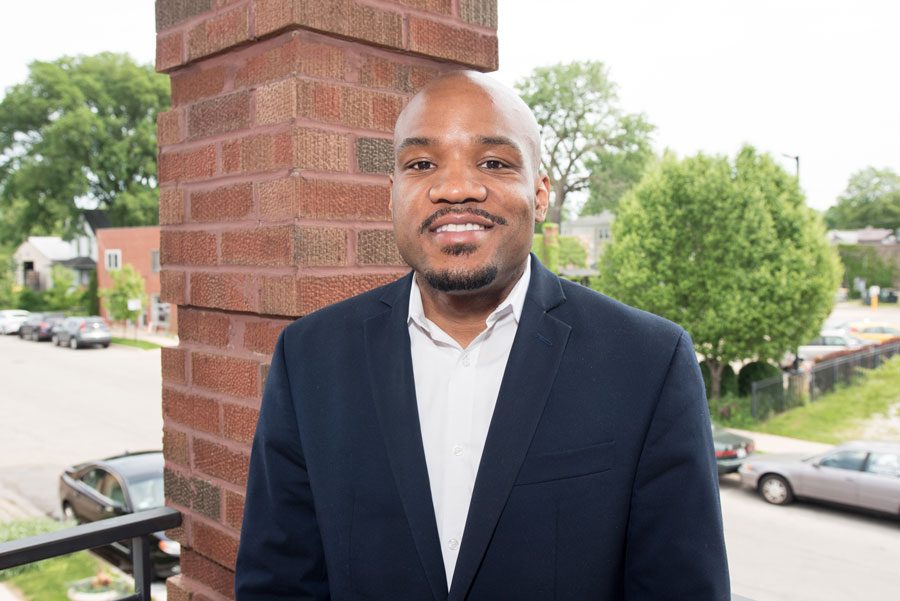
Bobby Burns, president and founder of community activism organization Evanston Collective.
Bobby Burns, president and founder of community activism organization Evanston Collective, said the school district should not have to bus an entire neighborhood across the city. He emphasized Evanston’s need to correct a “historical wrong,” which started with those initial integration efforts.
Burns said the lack of a school in the ward can send a certain message to community members as they grow up: that everything “of value” is located outside of the neighborhood. 
“If you want to go to the movies, you have to go outside of your neighborhood,” he said. “If you want to go to a kind of a well-staffed and well-resourced library, you have to go outside of your neighborhood. If you want to go to school and be educated, you have to go outside of your neighborhood.”
Bussed diversity
Every morning, Burns said he sees young people waiting at bus stops to be “shipped off” to other wards. This is happening as the percentage of black residents in the 5th Ward shrinks: Between 2000 and 2010, for example, the ward lost 1,222 of its black residents, or 37.8 percent.
He said reestablishing a school in the area would put pressure on other wards to integrate more diversity in their communities, as they then wouldn’t be relying on 5th Ward residents to achieve that goal.
Current 5th Ward alderman Robin Rue Simmons, who has been involved in efforts to bring a school to the ward, said she understands the community’s struggle.
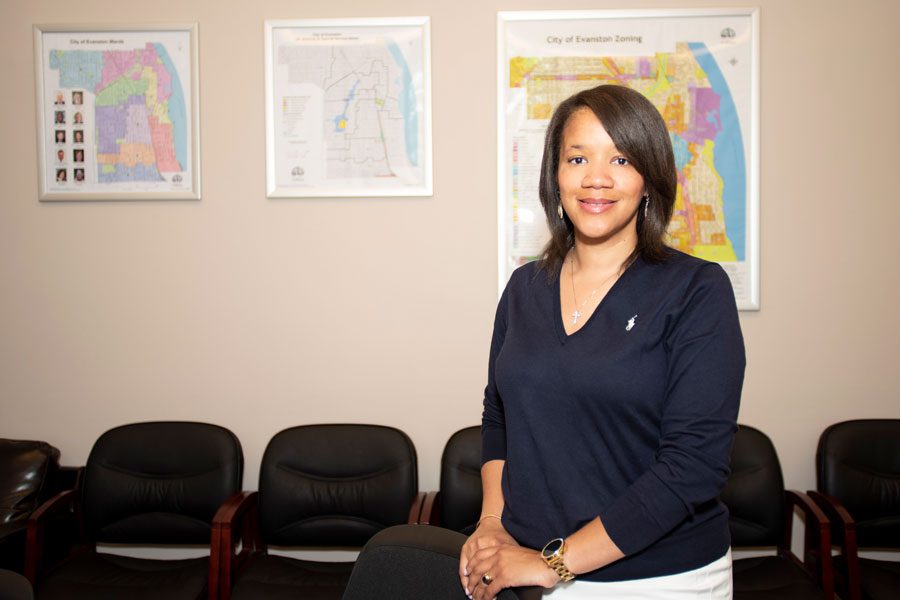
Ald. Robin Rue Simmons (5th).
In her experience, the geographical distance makes it difficult for 5th Ward parents to engage as easily as other parents in the school community. She said the transition for kids over the summer months can be hard as well — children in the 5th Ward often don’t attend the same programming as their friends, so a social gap begins to develop.
And because kids don’t live in the same neighborhood, Rue Simmons added that relationship building between children is tough. Play dates, she said, aren’t as convenient as a walk down the block after school.
“I know what it looks like … what it feels like to bus your kids to school, having bussed mine to Willard,” Rue Simmons said. “Knowing that our children are walking past the others that are playing after school on the playground, waiting for their parents to meet them at the playground. And ours are walking to a bus.”
The cornerstone of every thriving area is a school, Burns said, because it creates a neighborhood culture. Adding a school, he said, would support Rue Simmons’ goal of making the 5th Ward as “livable as any other ward.”
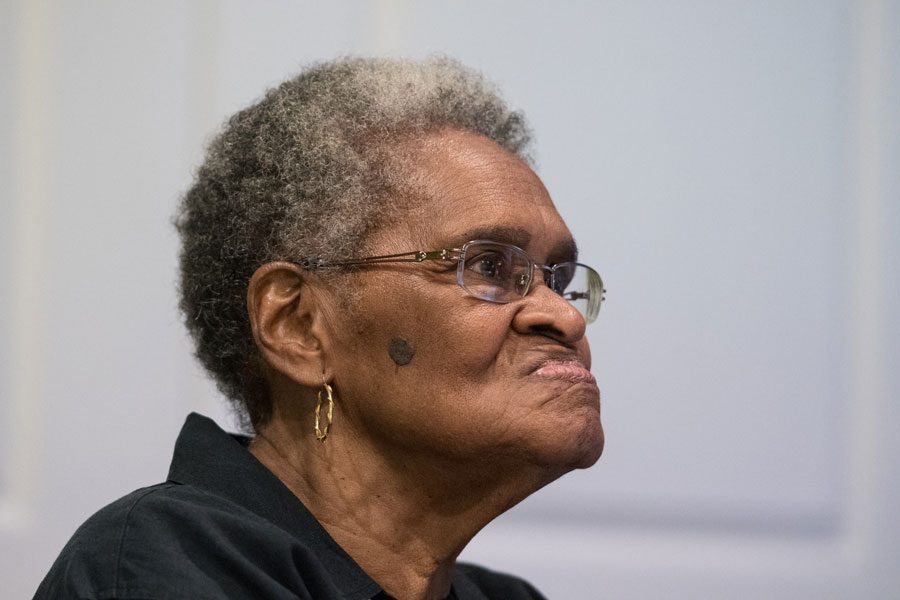
Former Ald. Delores Holmes (5th).
Delores Holmes, a former 5th Ward alderman, said the area’s residents don’t have the same level of agency as the District 65 school board.
“We don’t make the decisions, the school board really makes that decision,” Holmes said. “They did not take a (public) vote when they closed the building in ’79, so I didn’t understand why they ever had to take a vote to reopen the school in the 5th Ward, just doesn’t make any sense.”
The former alderman added that those affected by the loss of the school aren’t the right people to ask about the likelihood of it coming back.
“You’re asking the wrong people,” she said, “You have to ask the people with power for that.”
Dealing with financial realities
The financial burden District 65 faces in the coming years is significant, even after a crucial property tax referendum passed in April 2017, bolstering school funding to combat rising educational costs. Current projections estimate that district-wide expenditures will exceed revenues in Fiscal Year 2022, though referendum money will allow the district to sustain programs through Fiscal Year 2025 without a deficit.
None of these projections include the potential cost of a new school, which District 65 superintendent Paul Goren estimated would first cost about $25 million — if built from scratch — and then would run the district back about $5.7 million in operating costs annually, based on the current cost to operate an average school. Without a drastic change, he said, this is money the district does not have.
“The dramatic next steps would be to either raise class sizes significantly and/or to close a school,” Goren said. “We can cut on the margins here and there and everywhere, but … given what our financial situation is, even with the generous support of the referendum, we really would have to do something dramatic to be able to operate a new school.”
Goren stressed that without the operating costs, the community would have a “shell of a school,” with no money to afford hiring teachers, custodians or a principal. In addition, he said to purchase or even accept a building to house a school, the decision would have to be put to a referendum — as it was in 2012.
Debate over financial viability was a large factor in that year’s vote and in discussions on the topic over the past several decades. In 2003, then-District 65 board member Greg Klaiber stressed the inability of the board to support a primarily district-funded school.
“We have to be honest with the community,” Klaiber said in 2003. “We have to be really tough in light of those circumstances. I don’t think we should raise the hopes of a segment of the community when it’s not going to happen.”
Fifteen years later, Goren echoed many of the same concerns.
“We are all sensitive to the fact that children and families should have a school in their community,” Goren said. “That’s a key consideration, but it’s juxtaposed with the financial viability of it.”
Burns, who was part of the failed 2012 attempt to open a school in the ward, said the activists learned from the bid and this time, “everything is kind of lining up.”
“(Board members) understand the need for a school in the 5th Ward,” Burns said. “People have concerns about the financial realities that are going to play a part in determining whether or not it’s feasible, but I feel like there’s a commitment, there’s a willingness, and that’s suddenly different from the last time.”
Holding on to Family Focus
The building that once hosted Foster School — later renamed Dr. Martin Luther King Jr. Laboratory School — has been home to Family Focus’ Evanston location since the 1980s. This “gem” of a building, as Holmes called it, is on Dewey Avenue and quickly became a focal point of involvement, support and accessibility for the ward’s residents.
Family Focus’ mission is to promote children’s wellbeing by supporting and strengthening families in the community. The building houses different neighborhood programs as well as facilities that include a gym, a theater, a computer lab and an event space.
Colette Allen, director of the Evanston branch, said there are few locations in the 5th Ward that provide community members with spaces like the theater, which gives residents opportunities to practice skills such as public speaking.
“We’re almost a one-stop shop here,” Allen said.
Last year, Family Focus president and CEO Merri Ex announced that the organization could not maintain the costs of building ownership and upkeep for its Evanston chapter, which is why it was put up for sale.
Now, with revived efforts to bring a neighborhood school to the ward and the building on the market, there is a palpable uncertainty over the future of childhood programming in the community.
Rose Johnson, president of the auxiliary board for the Evanston nonprofit, said she is not keen on the idea of returning the Foster School building to its original purpose. More than 40 years ago, Johnson “made a wise move” to Evanston, she said. She now lives on Emerson Street just across from the 5th Ward and has contributed to Family Focus for many years.
She said the accessibility of the nonprofit is part of why it is so well-known in the 5th Ward. Johnson said she does not see a need for another school in the ward, but she does view Family Focus as irreplaceable.
“The use that (Family Focus) is being put to now is far superior to another school,” Johnson said. “It enables people who live in that area to get there without having to catch a bus or have a car. It’s a very convenient and reachable place for many different services.”
Rue Simmons, who grew up in the 5th Ward, said Family Focus gave her a safe haven and place of refuge that was accessible to community members, regardless of their needs or backgrounds. At Family Focus, she said she found mentors who wanted the best for her and advocated for her in the larger Evanston sphere.
She said the nonprofit’s presence in the Foster School building is important because it is located in the heart of the neighborhood. The space is multi-faceted, able to host everything from baby showers to wedding receptions to community meetings, she said. The organization is also able to help residents get referrals to housing opportunities, offer a weekly STEM program for children and match returning citizens — people released from prison — with employment.

Family Focus director Colette Allen smiles in a classroom at Family Focus. The classroom doubles as a space for students to work on art projects.
“I cannot see that building and all the potential that it has and all that it’s done for us go into the ownership of someone who doesn’t have the community on their heart,” she said.
She emphasized that it would be difficult to find a space with similar square footage and accommodations at the same rate to take in the programs currently housed in the facility. More importantly, she said, the building’s central location can’t be replicated.
George Dotson, whose family has owned property in the 5th Ward for nearly 100 years, attended Foster School in the 1950s. Sixty years later, he still finds himself at 2010 Dewey Ave. as an auxiliary board member at Family Focus. He said the school and the community center have cultivated his identity.
“That’s why I work with Family Focus: the (history), and being a member of the 5th Ward and being in this community,” Dotson said. “This is where I got my consciousness. This is where everything kind of started.”
Preserving the building
Holmes, the former 5th Ward alderman who was Family Focus’ first director for more than 25 years, serves on a committee whose interests lie in saving the Foster School building.
She said she was concerned with the building being sold because of its historical significance in the ward. The property, she said, is a “symbol of pride, of history and of service” for the community and the last visual representation of what the neighborhood used to be.
Currently, the committee is trying to raise funds to buy the building. She said members haven’t begun major fundraising yet — a big task because the roughly $5 million they would like to purchase, renovate and maintain the property doesn’t exist within the ward.
Still, Holmes said the pieces are falling into place, and she is pleased with how far the group has come, even though it is operating on a limited amount of time.
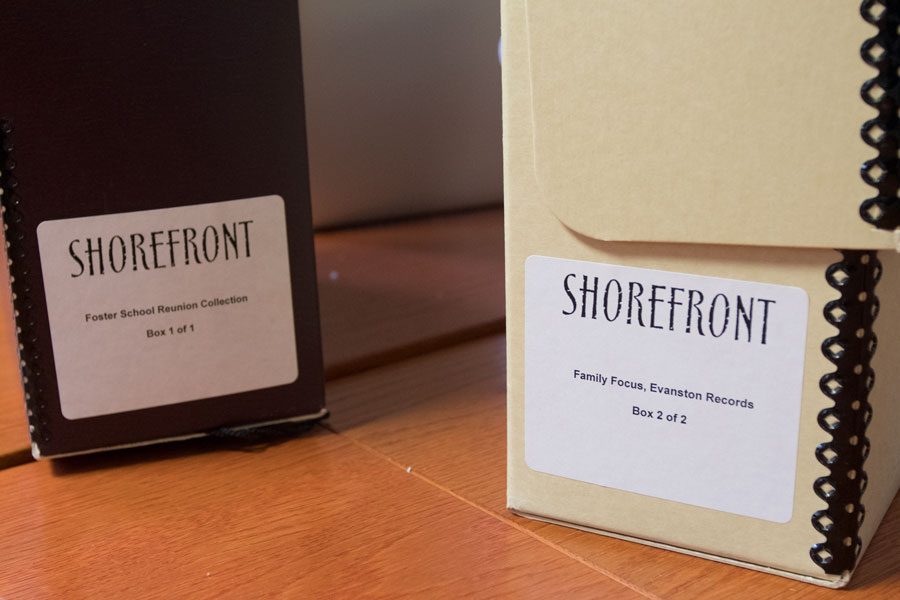
Collections of historical documents at Shorefront Legacy Center. Documents include archival information on Foster School reunions and Family Focus, Evanston records.
While these efforts to purchase the property are being made, Dino Robinson, the founder and interim director of Shorefront Legacy Center — which focuses on preserving the North Shore’s black history — is aiding attempts to get the Foster School location designated as a historical landmark. Robinson said the designation would help protect the building, preventing it from being completely razed by a buyer without proper approval and limiting additions that don’t conform to its architecture.
Robinson acknowledged that if the building is designated a historical landmark, it may hamper the sale of the property. Robinson added that several past attempts to preserve other buildings in Evanston that were important to the African-American community were not seen through.
However, he said the designation would provide a “symbolic moment” showing that the city was paying attention to the community’s desires.
It would also help create goodwill within the area — Robinson said on a personal level, he often felt that in the 5th Ward, new ideas were challenged more so than they were in other parts of the city.
“When it seems there is an effort for a new initiative or new development in this particular area of Evanston, the ideas stall or are sidelined or put on the back burner for a variety of different reasons,” Robinson said. “Whatever reasons you can fathom, that’s what the community hears from people who can sign the papers.”
The future of Foster
Eddie Lee Sutton, who was a speech and language clinician at Foster School for decades, wrote and published a book of poems called “Not For Blacks Only.” In one poem, she reflects on a fire that in 1958 burned down a wing of the school — which was later rebuilt — and wrote that the building stood for the dreams and hopes of the past and future.
“The future is now here,” Sutton wrote. “This building still we do revere. (Its) beacon still in our neighborhood. The changes have been very good, guiding again the youth to light and truth.”
Community stakeholder Henry Wilkins believes establishing a STEM school in Evanston is the best way he can help the city improve moving forward.
After researching the failed attempts of bringing a school into to the 5th Ward, he gathered a group of community leaders who understood what it would take to start a STEM-based one.
Having that focus in a proposal, Wilkins said, will draw people from all across the city and encourage them to be more receptive to the idea of establishing a school in the area.
“It cuts against race, it cuts against economic level — everyone is a big proponent of STEM,” Wilkins said. “I felt like having a school in the 5th Ward that people across Evanston would appreciate and want to go to would help with this idea of having diversity in the school district.”
In an email to The Daily, Wilkins said the Foster School building would probably be “the least costly and most attractive option” for a new school. He said the group of community leaders pushing for the STEM institution wants to do an assessment on whether it could fit in the building with existing programs.
The community leaders haven’t formally made a pitch for the school being at the property, he said, but a future pitch would include the school contributing lease payments to help sustain the building. He added that the group isn’t necessarily tied to District 65 and would perhaps consider pursuing a charter school.
Summers, the longtime 5th Ward resident, was more direct about his predictions.
“When there’s enough white kids over here, there will be a school over here,” Summers said. “And they’re moving in left and right.”
Summers said the ward is being gentrified in a big way, and that with each new family moving into the area, one of his “dear neighbors” has to go — something that is not a joyous occasion for him.
In the wake of the Foster School’s shuttering, he said, almost all of the things that had previously sustained the 5th Ward — a hospital, a YMCA and many black-owned businesses — have slowly disappeared as children were bussed out. He said the black community “has paid a huge price for this diversity that Evanstonians love.”
“Take children away, communities disappear,” Summers said. “That’s what happening right now. It’s been happening for a while now.”
Email: [email protected]
Twitter: @ryanwangman
Email: [email protected]
Twitter: @ColinBPhoto

